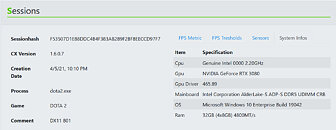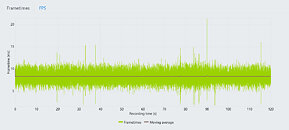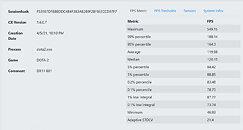Mar 26th, 2025 18:44 EDT
change timezone
Latest GPU Drivers
New Forum Posts
- Recommended PhysX card for 5xxx series? [Is vRAM relevant?] (224)
- Do you use Linux? (552)
- What are you playing? (23271)
- Do you prefer factory overclocked GPUs? (58)
- Dune: Awakening benchmark - post your results (43)
- First ever PC build (35)
- Core 200s (Bartlett Lake-S) Announced at CES 2025 (22)
- Is RX 9070 VRAM temperature regular value or hotspot? (239)
- WebAssembly imageConvolute benchmarking (19)
- What local LLM-s you use? (143)
Popular Reviews
- Assassin's Creed Shadows Performance Benchmark Review - 30 GPUs Compared
- be quiet! Pure Rock Pro 3 Black Review
- ASUS ProArt X870E-Creator Wi-Fi Review
- ASRock Radeon RX 9070 XT Taichi OC Review - Excellent Cooling
- Pulsar Feinmann F01 Review
- Sapphire Radeon RX 9070 XT Nitro+ Review - Beating NVIDIA
- ASRock Phantom Gaming B860I Lightning Wi-Fi Review
- Samsung 9100 Pro 2 TB Review - The Best Gen 5 SSD
- ASUS GeForce RTX 5070 TUF OC Review
- Sapphire Radeon RX 9070 XT Pulse Review
Controversial News Posts
- AMD RDNA 4 and Radeon RX 9070 Series Unveiled: $549 & $599 (260)
- MSI Doesn't Plan Radeon RX 9000 Series GPUs, Skips AMD RDNA 4 Generation Entirely (142)
- Microsoft Introduces Copilot for Gaming (123)
- AMD Radeon RX 9070 XT Reportedly Outperforms RTX 5080 Through Undervolting (118)
- NVIDIA Reportedly Prepares GeForce RTX 5060 and RTX 5060 Ti Unveil Tomorrow (115)
- Over 200,000 Sold Radeon RX 9070 and RX 9070 XT GPUs? AMD Says No Number was Given (100)
- NVIDIA GeForce RTX 5050, RTX 5060, and RTX 5060 Ti Specifications Leak (96)
- Retailers Anticipate Increased Radeon RX 9070 Series Prices, After Initial Shipments of "MSRP" Models (90)
Tuesday, May 11th 2021

Intel Alder Lake-S Engineering Sample Spotted with DDR5-4800 Memory Running DOTA 2
Intel's upcoming Alder Lake-S processors are going to be the company's first attempt at delivering heterogeneous core solutions, combining low-power and high-performance IPs in a single chip. Another important milestone that these processors will reach is DDR5 memory adoption, the first of its kind on consumer platforms. Today, thanks to CapFrameX, a monitoring tool that also hosts a database of benchmark runs, we have a piece of recorded information coming from a test system equipped with an Intel Alder Lake-S processor. The tested system spotted an engineering sample of the Alder Lake-S lineup, clocked at just 2.2 GHz. The core count and core configuration remained unknown.
Alongside the upcoming CPU, the system is composed of NVIDIA's GeForce RTX 3080 GPU and DDR5 memory running at 4800 MHz. There were four sticks present, each having 8 GB capacity. The leaked system was running the DOTA 2 game at an average of 119.98 FPS, which doesn't mean much, given that we don't know which settings were applied and what was the resolution. There is a chart showing the gaming frame rate and frame time, which could be interesting to look at. However, the only new information we have come to know is that the Alder Lake-S is already capable of playing games and the ecosystem support should be very good at launch.
Sources:
CapFrameX, via VideoCardz
Alongside the upcoming CPU, the system is composed of NVIDIA's GeForce RTX 3080 GPU and DDR5 memory running at 4800 MHz. There were four sticks present, each having 8 GB capacity. The leaked system was running the DOTA 2 game at an average of 119.98 FPS, which doesn't mean much, given that we don't know which settings were applied and what was the resolution. There is a chart showing the gaming frame rate and frame time, which could be interesting to look at. However, the only new information we have come to know is that the Alder Lake-S is already capable of playing games and the ecosystem support should be very good at launch.
Mar 26th, 2025 18:44 EDT
change timezone
Latest GPU Drivers
New Forum Posts
- Recommended PhysX card for 5xxx series? [Is vRAM relevant?] (224)
- Do you use Linux? (552)
- What are you playing? (23271)
- Do you prefer factory overclocked GPUs? (58)
- Dune: Awakening benchmark - post your results (43)
- First ever PC build (35)
- Core 200s (Bartlett Lake-S) Announced at CES 2025 (22)
- Is RX 9070 VRAM temperature regular value or hotspot? (239)
- WebAssembly imageConvolute benchmarking (19)
- What local LLM-s you use? (143)
Popular Reviews
- Assassin's Creed Shadows Performance Benchmark Review - 30 GPUs Compared
- be quiet! Pure Rock Pro 3 Black Review
- ASUS ProArt X870E-Creator Wi-Fi Review
- ASRock Radeon RX 9070 XT Taichi OC Review - Excellent Cooling
- Pulsar Feinmann F01 Review
- Sapphire Radeon RX 9070 XT Nitro+ Review - Beating NVIDIA
- ASRock Phantom Gaming B860I Lightning Wi-Fi Review
- Samsung 9100 Pro 2 TB Review - The Best Gen 5 SSD
- ASUS GeForce RTX 5070 TUF OC Review
- Sapphire Radeon RX 9070 XT Pulse Review
Controversial News Posts
- AMD RDNA 4 and Radeon RX 9070 Series Unveiled: $549 & $599 (260)
- MSI Doesn't Plan Radeon RX 9000 Series GPUs, Skips AMD RDNA 4 Generation Entirely (142)
- Microsoft Introduces Copilot for Gaming (123)
- AMD Radeon RX 9070 XT Reportedly Outperforms RTX 5080 Through Undervolting (118)
- NVIDIA Reportedly Prepares GeForce RTX 5060 and RTX 5060 Ti Unveil Tomorrow (115)
- Over 200,000 Sold Radeon RX 9070 and RX 9070 XT GPUs? AMD Says No Number was Given (100)
- NVIDIA GeForce RTX 5050, RTX 5060, and RTX 5060 Ti Specifications Leak (96)
- Retailers Anticipate Increased Radeon RX 9070 Series Prices, After Initial Shipments of "MSRP" Models (90)



7 Comments on Intel Alder Lake-S Engineering Sample Spotted with DDR5-4800 Memory Running DOTA 2
Too many Watts, too much heat, and barely a change in performance.
Although Cinebench scores show changes in performance, my ancient 4790k’s, 5775C and 8086k show little change outside of extra cores.
Great News
And current processors already do that in a way, in that if you are not doing some demanding job, only some cores will be active and not even run at max frequency, the processor will boost to base core if it needs to and if there is need it will ramp it up to the max boost clock.